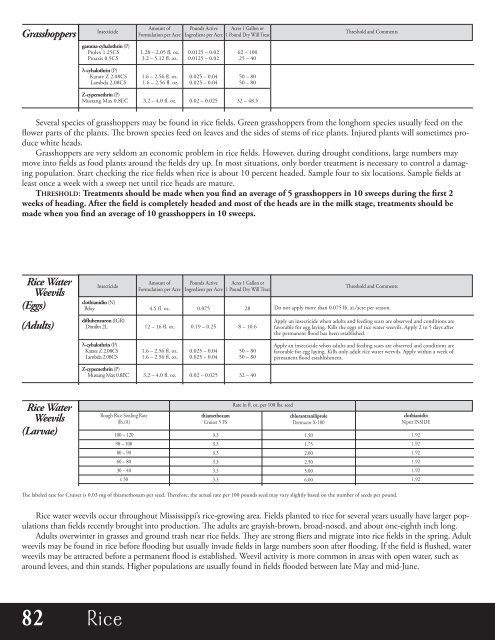Agronomic Crops
mJyPrJ
mJyPrJ
You also want an ePaper? Increase the reach of your titles
YUMPU automatically turns print PDFs into web optimized ePapers that Google loves.
Grasshoppers<br />
Insecticide<br />
Amount of<br />
Formulation per Acre<br />
Pounds Active<br />
Ingredient per Acre<br />
Acres 1 Gallon or<br />
1 Pound Dry Will Treat<br />
Threshold and Comments<br />
gamma-cyhalothrin (P)<br />
Prolex 1.25CS<br />
Proaxis 0.5CS<br />
1.28 – 2.05 fl. oz.<br />
3.2 – 5.12 fl. oz.<br />
0.0125 – 0.02<br />
0.0125 – 0.02<br />
62 – 100<br />
25 – 40<br />
λ-cyhalothrin (P)<br />
Karate Z 2.08CS<br />
Lambda 2.08CS<br />
1.6 – 2.56 fl. oz.<br />
1.6 – 2.56 fl. oz.<br />
0.025 – 0.04<br />
0.025 – 0.04<br />
50 – 80<br />
50 – 80<br />
Z-cypemethrin (P)<br />
Mustang Max 0.8EC<br />
3.2 – 4.0 fl. oz.<br />
0.02 – 0.025<br />
32 – 48.5<br />
Several species of grasshoppers may be found in rice fields. Green grasshoppers from the longhorn species usually feed on the<br />
flower parts of the plants. e brown species feed on leaves and the sides of stems of rice plants. Injured plants will sometimes produce<br />
white heads.<br />
Grasshoppers are very seldom an economic problem in rice fields. However, during drought conditions, large numbers may<br />
move into fields as food plants around the fields dry up. In most situations, only border treatment is necessary to control a damaging<br />
population. Start checking the rice fields when rice is about 10 percent headed. Sample four to six locations. Sample fields at<br />
least once a week with a sweep net until rice heads are mature.<br />
tHResHoLD: treatments should be made when you find an average of 5 grasshoppers in 10 sweeps during the first 2<br />
weeks of heading. After the field is completely headed and most of the heads are in the milk stage, treatments should be<br />
made when you find an average of 10 grasshoppers in 10 sweeps.<br />
Rice Water<br />
Weevils<br />
(Eggs)<br />
Insecticide<br />
clothianidin (N)<br />
Belay<br />
Amount of<br />
Formulation per Acre<br />
4.5 fl. oz.<br />
Pounds Active<br />
Ingredient per Acre<br />
0.075<br />
Acres 1 Gallon or<br />
1 Pound Dry Will Treat<br />
28<br />
Threshold and Comments<br />
Do not apply more than 0.075 lb. ai./acre per season.<br />
(Adults)<br />
diflubenzuron (IGR)<br />
Dimilin 2L<br />
12 – 16 fl. oz.<br />
0.19 – 0.25<br />
8 – 10.6<br />
Apply an insecticide when adults and feeding scars are observed and conditions are<br />
favorable for egg laying. Kills the eggs of rice water weevils. Apply 2 to 5 days after<br />
the permanent flood has been established.<br />
λ-cyhalothrin (P)<br />
Karate Z 2.08CS<br />
Lambda 2.08CS<br />
1.6 – 2.56 fl. oz.<br />
1.6 – 2.56 fl. oz.<br />
0.025 – 0.04<br />
0.025 – 0.04<br />
50 – 80<br />
50 – 80<br />
Apply an insecticide when adults and feeding scars are observed and conditions are<br />
favorable for egg laying. Kills only adult rice water weevils. Apply within a week of<br />
permanent flood establishment.<br />
Z-cypemethrin (P)<br />
Mustang Max 0.8EC<br />
3.2 – 4.0 fl. oz.<br />
0.02 – 0.025<br />
32 – 40<br />
Rice Water<br />
Weevils<br />
(Larvae)<br />
Rough Rice Seeding Rate<br />
(lb./A)<br />
100 – 120<br />
90 – 100<br />
80 – 90<br />
60 – 80<br />
30 – 40<br />
≤ 30<br />
thiamethoxam<br />
Cruiser 5 FS<br />
3.3<br />
3.3<br />
3.3<br />
3.3<br />
3.3<br />
3.3<br />
Rate in fl. oz. per 100 lbs. seed<br />
chlorantraniliprole<br />
Dermacor X-100<br />
1.50<br />
1.75<br />
2.00<br />
2.50<br />
5.00<br />
6.00<br />
clothianidin<br />
Nipsit INSIDE<br />
1.92<br />
1.92<br />
1.92<br />
1.92<br />
1.92<br />
1.92<br />
e labeled rate for Cruiser is 0.03 mg of thiamethoxam per seed. erefore, the actual rate per 100 pounds seed may vary slightly based on the number of seeds per pound.<br />
Rice water weevils occur throughout Mississippi’s rice-growing area. Fields planted to rice for several years usually have larger populations<br />
than fields recently brought into production. e adults are grayish-brown, broad-nosed, and about one-eighth inch long.<br />
Adults overwinter in grasses and ground trash near rice fields. ey are strong fliers and migrate into rice fields in the spring. Adult<br />
weevils may be found in rice before flooding but usually invade fields in large numbers soon after flooding. If the field is flushed, water<br />
weevils may be attracted before a permanent flood is established. Weevil activity is more common in areas with open water, such as<br />
around levees, and thin stands. Higher populations are usually found in fields flooded between late May and mid-June.<br />
82 Rice


